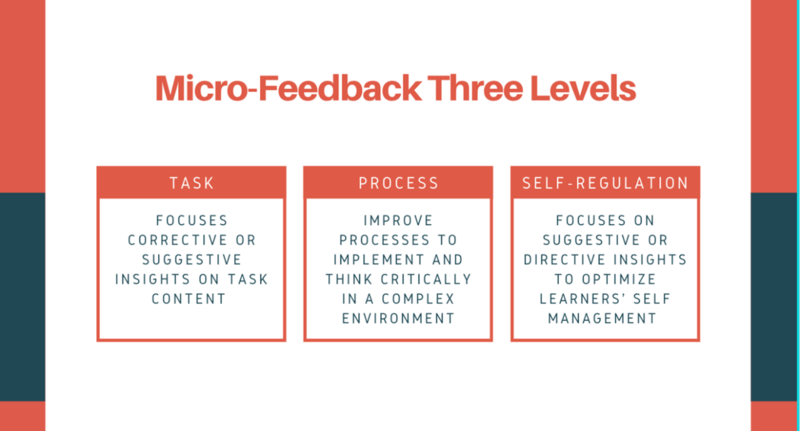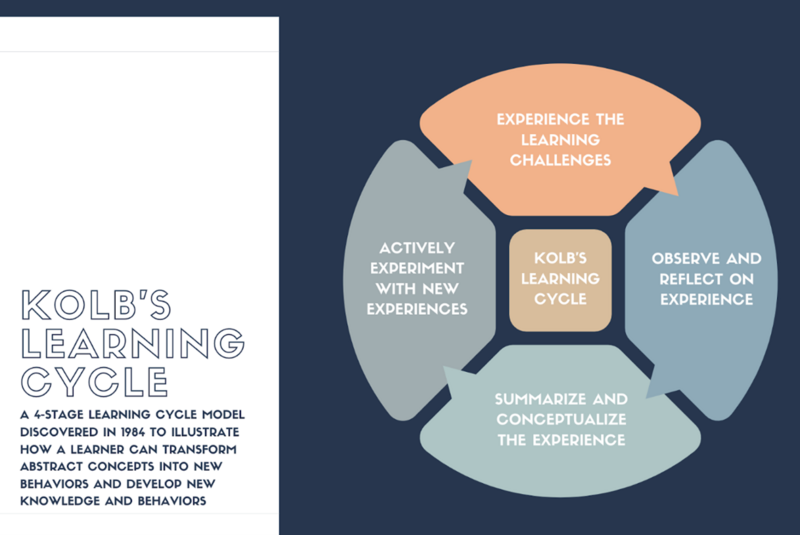ATD Blog
How to Design Effective Micro-Feedback Toward Behavior Change
Mon May 16 2022

Bookmark
Everyone knows that feedback is important, but how to give effective feedback often puzzles us. This post will:
Introduce the basics of micro-feedback and show how micro-feedback is a more effective way to nudge learners toward behavior change.
Examine micro-feedback from three levels (task, process, and self-regulation).
Connect micro-feedback with Kolb’s four phase experiential learning model.
Overview some research-based best practices.
Why Does Micro-Feedback Matter?
Micro-feedback, or a specific and just-in-time nano dose of information or insights, reduces competency gaps between goals and reality. Think of it as a “microscope” used to diagnose a learner’s comprehension and behavior and prescribe micro-interventions to adjust performance and prevent mistakes. Micro-feedback is usually implemented in a microlearning or nudge environment where complex tasks and goals are scaffolded into much simpler and specific learning tasks.
People often give feedback after a series of actions have taken place. Feedback usually addresses a few key observations for future improvements; however, in a situation when actions and sequences are quite complicated and interdependent, it would fail to provide useful insights to improve performance. Micro-feedback potentially can prevent critical mistakes and mitigate risks in industries such as healthcare, finance, and manufacturing, where safety and compliance are critical.
For example: A nurse practitioner wrote an inpatient admission order stating a patient should be admitted to the fourth floor. The order was considered invalid, and the entire patient stay was denied.
General feedback was provided after the incident: “Designate the correct personnel to write patient admission notice in the correct terms.” As a result, the nurse still doesn’t understand what went wrong and how to improve performance next time.
Micro-feedback will be provided during the incident. One piece of micro-feedback will be provided after the nurse has written the order: “Check to see if the nurse practitioner is the correct person to submit the admission order.” With that feedback, the nurse will realize that only midlevel providers can write such admission orders on their own authority. The second piece of micro-feedback will be provided after the order is created: “Check to see if the order contains ‘admit as an inpatient’ to stay valid.”
Through such timely insights and easy-to-accomplish learning objectives, learners are more likely to gain deep clarity and stay motivated to modify their performance. As a result of micro-feedback, the patient can be admitted and start treatment. Using this micro-feedback as a reflection activity, nurses will know what went wrong and how to adjust behaviors next time.

The 3 Levels of Micro-Feedback
Micro-feedback is a type of micro-consequence of performance. Based on basic types of feedback, effective micro-feedback can be categorized into three levels:
1. Task-based micro-feedback focuses corrective or suggestive insights on the content of a task. For example, “Please provide the patient with a list of all of the providers of these services in the area when giving referrals to nursing homes and home care.” Research has also shown that to provide a higher learner impact toward new behavior, managers need to focus micro-feedback on the correct actions rather than incorrect performance.
2. Process-based micro-feedback focuses on the learning processes and works best to foster critical thinking in a complex environment. For example, “This customer complaint can be further processed based on the decision tree strategies we talked about earlier.”
3. Self-regulation-based micro-feedback focuses on giving suggestive or directive insights helping learners to better manage and regulate their own learning. For example, “Pause once you have completed the required task and ask yourself a set of questions following the SMART formula.”

Micro-Feedback Timing and Kolb’s Experiential Learning Model
David Kolb, an expert in experiential learning, published a four-stage learning cycle model in 1984 to illustrate how a learner can transform abstract concepts into new behaviors and develop new knowledge. His model has been validated by many researchers.
According to the four continuous stages of Kolb’s experiential learning model, learners:
1. Encounter a new concrete learning experience.
2. Observe, reflect, and identify any gaps between experience and understanding. This stage requires heavy micro-feedback from managers or multiple sources of external partners, such as customers, co-workers, subordinates, and other stakeholders.
3. Conceptualize and modify previous understanding and develop new understanding, ideas, and behaviors.
4. Apply the new internal paradigm into new behaviors and continue to receive micro-feedback from the environment for future learning and development.
A continuous process of the micro-feedback loop plays a critical role to guide learners’ consistent transformation and accommodates their weaknesses. As a result, learners can build a continuous process of goal-directed learning actions throughout the learning process and increase the chance to deliver new behaviors.

Evidence-Based Micro-Feedback Practices Toward Behavior Change
High-impact micro-feedback occurs when goals are specific and challenging, but tasks complexity is low.
Before sharing any micro-feedback, a manager or instructor needs to equip learners with a certain level of proficiency through clear instructions and elaboration.
Aim to close the gap between where the learner is and where the learner aims to be.
Well-strategized micro-feedback can ease learners from task-oriented to process-oriented.
Deliver continuous micro-feedback throughout Kolb’s experiential learning stages, especially the second and third stages.
Micro-feedback is more effective when learners receive it well and act on it.
Provide specific cues or reinforcement toward a well-understood task and focus on levels of task, process, or self-regulation.
To encourage new behaviors during change management, provide positive micro-feedback on correct, rather than incorrect, performance.
Positive feedback such as, “You are a great learner,” is unrelated to performance or tasks and is not effective. Negative feedback on self or personality creates a threat and distracts attention from learning. Try to avoid negative feedback directed to self, role, or personality, because it can easily demotivate the learner and reduce the courage to err and grow.
Bottom Line
Micro-feedback is a nano dose of information or insights to reduce competency gaps between goals and reality. It is usually implemented in a complex environment where complex tasks and goals are scaffolded into much simpler and specific learning tasks. Micro-feedback can be provided on three levels: task, process, and self-regulation. It will have maximum impact if it is given in consideration of Kolb’s experiential learning model as learners move through concrete experience, reflective observation, abstract conceptualization, and active experimentation. A continuous process of micro-feedback loop plays a critical role to guide learners’ consistent transformation and accommodates their weaknesses, and as a result, learners are able to build a continuous process of goal-directed learning actions throughout the learning process and increase the chance to deliver new behaviors. As learners gain greater fluency and mastery, they will have more confidence to face challenging tasks and goals.
Explore more
More from ATD

